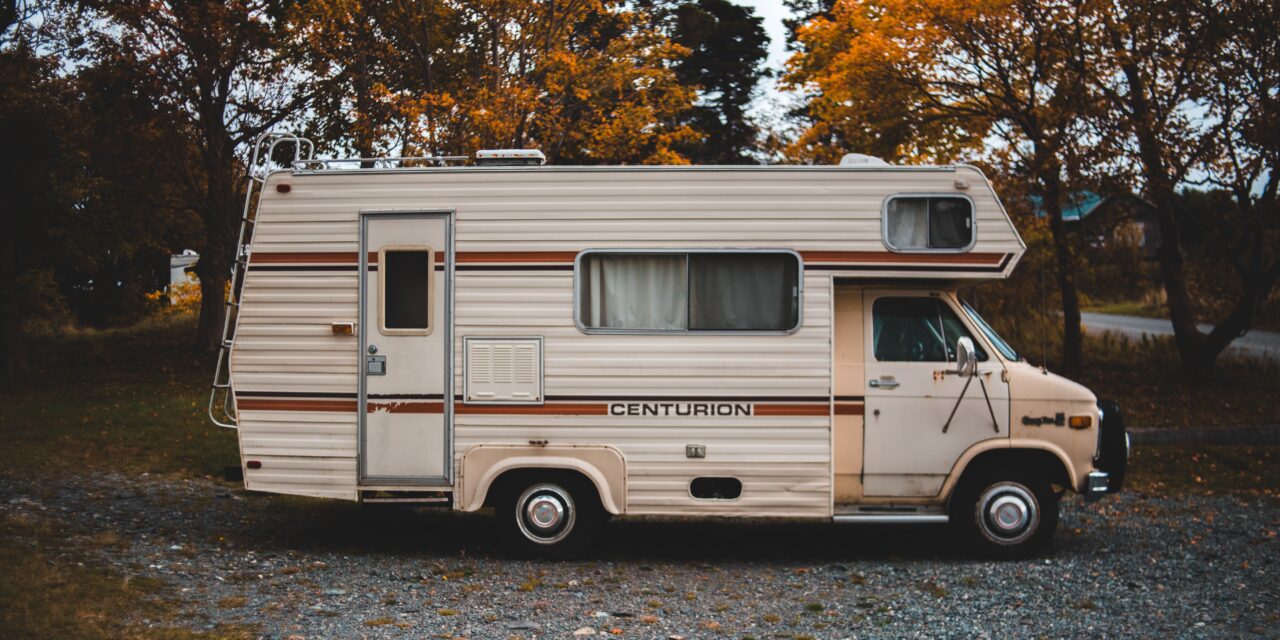If you’re planning on long-term RV storage, there are several things to consider before you put it away. One of the most important is knowing how to prevent mold in your RV during storage.
Fortunately, the experts at Price Self Storage have come up with a list of 13 tips for RV mold prevention. We’ll show you everything you need to know about how to keep moisture out of an RV in storage and make sure it stays mold-free.
How Does Mold Form?
Mold can present issues for your vehicle’s health — and yours — so it’s important to know what causes mold and how to identify it. Nipping the problem in the bud early could save you money and hassle down the road. According to Insider Living:
“Mold is caused by mold spores (which are naturally present in our environment) that find a moist, dark place to grow. RVs are especially good incubators for these spores since they are frequently closed up and stored for long periods of time. When an RV is stored, moisture can get trapped inside the RV and help to feed the mold growth.”
Although mold can be seen on your RV’s walls, carpet, or flooring, the easiest way to detect it is through the musty smell. Mold tends to have a dank or musty odor that’s immediately apparent. Left untreated, mold will dig in and spread, which can lead to respiratory issues. By employing prevention methods and fighting mold early on, you can protect both your RV and your passengers.
How To Keep Mold Out of Your Camper During Storage
Dampness and lack of airflow are the primary causes of mold. So the best way to keep mold out of your RV is to remove as much moisture as possible. Here’s exactly what you need to know about how to keep moisture out of an RV in winter (and while in storage).
1. Inspect Your RV
Before you store away your recreational vehicle, it’s vital that you perform a rigorous inspection of the RV’s interior and exterior for damage or the presence of moisture. If you identify issues, fix them. Similarly, check the vehicle’s plumbing, particularly around the toilets and sinks. Once more, if issues are discovered, repair them sooner than later.
2. Use a Dehumidifier
When it comes to RV mold prevention, moisture is the enemy. Before placing your RV into storage, run a dehumidifier in your vehicle. The dehumidifier will suck moisture from the air inside your RV and put it into a collection unit that you can empty. You can find dehumidifiers for campers online.
Run the dehumidifier for at least a few hours before putting your RV into storage. Ideally, you should run it for a few days. Keep the RV or camper closed during this time so no additional moisture can get in.
If your storage spot includes an electrical hookup, you may even want to consider running a small dehumidifier while your RV is in storage.
3. Rent an Indoor Storage Unit
One of the best ways to protect your RV or camper from mold and mildew is to store your vehicle in a fully enclosed storage unit. Indoor storage units may be more expensive than outdoor units, but you could save money in the long run if you prevent a mold outbreak. Indoor storage will protect your RV from rain, dew, fog, and everyday condensation.
Few storage sites in California offer indoor storage for RVs, but Price Self Storage’s Solana Beach location has the largest indoor RV storage facility in Southern California.
4. Blow Out Fresh Water Lines
Even if a visual inspection results in zero major issues, it’s wise to blow out all freshwater tanks and plumbing lines. Any water left in your RV, even in the water lines, can increase your risk of a mold outbreak. Consider using an air compressor to help you fully empty your water lines. This will ensure that the whole water system is clear.
5. Use Desiccants
Desiccants are materials that help absorb moisture from the environment within your RV. They come in several forms, including crystal packets, chemical packets, or clay desiccants. The best moisture absorbers for an RV are desiccants designed specifically for campers. These include large packets designed for bigger spaces or even hanging packets you can put in your closets. Ideally, you’ll want to place packets throughout your RV so you can catch as much leftover moisture as possible during storage.
6. Use a Proper RV Cover
If you can’t store your vehicle inside, it’s smart to cover it with a specialized RV cover tarp. You’ll need to find a cover that is waterproof from the outside and can vent water vapor from the RV. Make sure your cover also protects against UV rays; over time, UV from the sun can damage seals around your windows and doors, making it easy for moisture to get into your camper.
7. Remove Fabrics Before Storage
Fabrics tend to hang onto moisture and could be a haven for mold or mildew if left in your RV for a long time. Before you put your RV into storage, remove all fabrics from your vehicles. These can include:
- Blankets
- Sheets
- Towels
- Clothes
- Fabric curtains
You may even want to take out couch cushions and/or mattresses if you have space to store them at home.
8. Open Closets, Cupboards, Windows, and Roof Vents
Mold and mildew can form because condensation never dries out. By opening up the RV’s windows and vents, you can ensure that air flows inside the RV. Additionally, opening closets and cupboards helps prevent moisture from staying trapped in these places. Of course, you’ll only want to open your windows and vents if your RV is stored indoors.
9. Wipe Down All Surfaces
Even the smallest bit of moisture can promote mold or mildew growth. So before you put your vehicle in storage, wipe down every surface to remove any moisture or condensation. Make sure to do a thorough wipe-down — go deep. Get into the backs of closets, under furniture, and deep into cabinets. Pay extra attention to wiping down the bathroom, kitchen, sink, and countertops.
10. Inspect for Any Leaks or Exterior Cracks
Before you lock up your RV, go over it with a fine-tooth comb. Look for any cracks or leaks that could let moisture in. Be sure to check vents, windows, doors, and the roof.
Look for signs of leaks, such as:
- Bubbling
- Cracks
- Rust spots
- Cracked caulking
- Spots of discoloration
- Mildew smells
While you can perform this inspection on your own, you may also want to request a professional inspection just to be double sure your RV is good to store.
11. Run a Heater
A heater can help evaporate condensation or humidity before you store your RV. If you have a heater, plug it in and let it run for a few hours or even longer before putting your vehicle into storage.
12. Use a Fan
After you run the dehumidifier and heater, run a fan in your RV to dry up any last amount of moisture that might still be hanging around. If your storage area includes an electrical hookup, you may want to keep a small fan running to maintain airflow throughout your RV.
13. Inspect Your Camper or RV at Least Once a Month
You may be tempted to shut the door on your storage facility and not check back on your RV until the weather warms and you’re ready to hit the open road again. However, if there’s mold in your RV, it could grow during that time and cause a lot of damage. That’s why it’s a good idea to check your RV once a month.
Visit your storage facility and give your RV a visual inspection. Look for signs of moisture. Smell the air inside your RV. If there’s enough mildew, your nose can be a great detector. If you’re using moisture packets, consider replacing them. Now is also a good time to run a dehumidifier, a heater, or a fan for a few hours before you lock up again.
If You Find Mold and Mildew, Treat It Immediately
The longer you wait to treat mold, the harder it will be to get out. By performing regular inspections (at least once a month), you can spot the early warning signs of mold and then take the proper actions before it has a chance to get out of hand. Then, address the root causes of the mold (leaks, excess moisture, etc.) so that it stays away.
By taking just these steps, you will dramatically reduce the likelihood of mold being a long-term issue.
Price Self Storage Is Built for RVs
The facilities at Price Self Storage were designed specifically with RVs in mind. We have extra–wide driveways and a range of dedicated spot sizes available. Several of our facilities provide fantastic RV storage, including:
- Azusa RV Storage — West Foothill Blvd.
- West Los Angeles RV Storage — South La Brea Ave.
- Norco RV Storage — Cota St.
- San Diego RV Storage — Murphy Canyon Rd.
- Solana Beach RV Storage — Stevens Ave. West
Protect Your RV at Price Self Storage
Your first step for preventing mold in your RV is to choose the right storage facility. Price Self Storage offers affordable RV storage, including indoor RV storage units. We also support RV mold prevention by making it easy for you to regularly inspect your vehicle. We are open seven days a week from 7 a.m. to 7 p.m. (except for major holidays). We also offer our customers a wide range of information, like this article on long-term RV storage tips.
At Price Self Storage, our mission is to help make storage simple — especially for RVs! Our team of experts has years of experience with RV storage and is ready to assist you if you need help or have a question.
Extending the life of your RV means you can enjoy more adventures in the future. Contact Price Self Storage today to find out how easy and affordable it is to store your RV with us!










